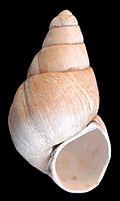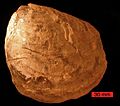Index fossils facts for kids
Index fossils (also known as guide fossils, indicator fossils or zone fossils) are fossils used to define and identify geologic periods (or faunal stages). They work on the premise that, although different sediments may look different depending on the conditions under which they were laid down, they may include the remains of the same species of the fossil. If the species concerned were short-lived (in geological terms, lasting a few hundred thousand years), then it is certain that the sediments in question were deposited within that narrow time period. The shorter the lifespan of a species, the more precisely different sediments can be correlated, and so rapidly evolving types of fossils are particularly valuable. The best index fossils are common, easy-to-identify at species level, and have a broad distribution—otherwise the likelihood of finding and recognizing one in the two sediments is minor.
Ammonites fit these demands well, and are the best-known fossils that have been widely used for this. Other important groups that provide index fossils are the corals, graptolites, brachiopods, trilobites, and echinoids (sea urchins). Conodonts may be identified by experts using light microscopy such that they can be used to index a given sample with good resolution. Fossilized teeth of mammals have also been used.
Geologists use both large fossils (called macrofossils) and microscopic fossils (called microfossils) for this process, known as biostratigraphy. Macrofossils have the advantage of being easy to see in the field, but they are rarer, and microfossils are very commonly used by oil prospectors and other industries interested in mineral resources when accurate knowledge of the age of the rocks being looked at is needed.
The series of deposits that spans the occurrence of a particular index fossil, is often referred to as that fossil's zone, enabling to relate different faunas through time. An example would be to say that Mesolenellus hyperborea occurs in the late Nevadella-zone.
List of common index fossils
| Fossil | Scientific Name | Time Period | Million Years Ago |
|---|---|---|---|
 Calico Scallop |
Pecten gibbus Argopecten gibbus |
Quaternary Period | 1.8 million years ago |
| Neptunea tabulata | Quaternary Period | 1.8 million years ago | |
 |
Viviparus glacialis | Tiglian (Early Pleistocene) | 0.5 million years ago |
| Calyptraphorus velatus | Tertiary Period | ||
| Venericardia planicosta | Eocene | ||
 Scaphites |
Scaphites hippocrepis | Cretaceous Period | 145 to 66 million years ago |
 Inoceramus |
Inoceramus labiatus | Cretaceous Period | |
 Perisphinctes |
Perisphinctes tiziani | Jurassic Period | |
| Nerinea trinodosa | Jurassic Period | ||
| Tropites subbullatus | Triassic Period | ||
| Monotis subcircularis | Triassic Period | ||
 Leptodus |
Leptodus americanus | Permian Period | |
| Parafusulina | Parafusulina bosei | Permian Period | |
| Dictyoclostus americanus | Pennsylvanian Period | ||
| Lophophyllidium proliferum | Pennsylvanian Period | ||
| Cactocrinus multibrachiatus | Mississippian Period | ||
| Prolecanites gurleyi | Mississippian Period | ||
 Mucrospirifer |
Mucrospirifer mucronatus | Devonian Period | 416 to 359 million years ago |
| Palmatolepis unicornis | Devonian Period | ||
| Silurian Period | |||
| Tetragraptus fructicosus | Ordovician Period | ||
 |
Paradoxides | Cambrian Period | 509 to 500 million years ago |
| Billingselia corrugata | Cambrian Period | ||
 |
Archeocyathids | Lower Cambrian | 529 to 509 million years ago |


